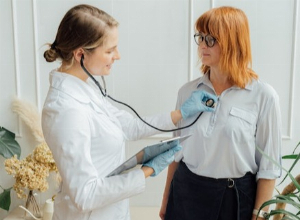Follow-up care after breast cancer treatment
Published Oct 17, 2022 • Updated Oct 18, 2022 • By Claudia Lima
Breast cancer affects 1 in 8 women.
It is now known that early diagnosis of breast cancer leads to a cure rate of almost 90% and reduces the mortality rate of this disease.
When treatment is finished, regular follow-up visits are organized for patients; this follow-up may last for several years, and is essential for patients' health.
What is the follow-up care after breast cancer treatment like? What does it involve? How long does it last?
Read our article to find out!

Breast cancer is the most common cancer in women. However, both its incidence and mortality rate have been decreasing in recent years.
When breast cancer is diagnosed, a treatment plan is set up. It may include radiotherapy, chemotherapy, hormone therapy and/or surgery.
As with all other cancers, the aim of the treatment is to achieve and maintain remission, i.e. a reduction in or disappearance of the symptoms of the disease. Remission is complete when no more cancer cells can be detected in the body. Cancer is considered cured when the duration of remission is declared sufficient.
At the end of these treatments, follow-up care is provided for each patient.
Why medical follow-up is recommended after breast cancer?
Once breast cancer treatment is finally over, patients need regular monitoring visits for several years to ensure that cancer does not return.
This monitoring is carried out in order to:
- Detect the symptoms of a possible recurrence of breast cancer or the appearance of a new cancer in the same breast, in the other breast or in another area of the body, as early as possible
- Detect and manage the possible late side effects of the treatment,
- Do a complete health check-up and make sure you are up-to-date with your vaccinations (not possible during chemotherapy and targeted therapy until 6 months after the treatment),
- Implement the necessary support care to restore and/or preserve the patient's quality of life as best as possible, managing physical and psychological consequences of cancer,
- Facilitate social and professional reintegration.
How long does the follow-up care last for and who is it organized by?
Depending on the type of cancer, the follow-up schedule is set up for a minimum of 5 years and can be continued for life. The follow-up schedule should be specified in an end-of-treatment report and given to the attending physician.
The attending physician and the referring medical team who carried out the treatment are responsible for this follow-up.
The attending physician adapts to each situation: the schedule can be modified, as the severity of the disease and the risks of recurrence differ from patient to patient.
Certain characteristics of cancer can be used to detect its recurrence risks. The risk factors for recurrence are quite numerous: age, tumor size, histology, cancer grade, etc.
What does the follow-up care for breast cancer patients include?
In general, the follow-up care for breast cancer patients includes:
- A doctor's appointment every 6 months for 5 years, and then once a year for several years or for life,
- A mammogram once a year, combined with a breast ultrasound if necessary,
- A gynecological exam once a year.
In case of abnormalities detected via medical imaging or in case of abnormal symptoms, additional examinations are prescribed. PET scans and breast scintigraphy are not necessary.
Women are advised to perform breast self-evaluation throughout their follow-up care as well as throughout all their lives.
There are women who are at high risk of recurrence: those who developed breast cancer before the age of 35 or those whose breast cancer has genetic mutations. A breast MRI should be performed every year.
During their appointments patients should discuss with their doctors any symptoms they may experience, as well as late side effects of their treatment, and their physical, emotional and psychological health. Depending on the difficulties encountered, the doctor may refer the patient to other specialists such as a psychologist, a physiotherapist, a sexologist and a social worker, among others.
How to have a proper follow-up care after breast cancer treatment?
To ensure a proper follow-up care after breast cancer treatment, the patient is advised to follow certain recommendations, such as:
- Scrupulously follow the prescribed treatment plan,
- Be sure to respect the rhythm of medical appointments and examinations established by the attending physician, your care team and other healthcare professionals,
- Do not hesitate to ask questions, take an active interest in your disease and your recovery, prepare for your appointments in advance,
- Gather information about the disease, the treatments and the possible side effects to better understand them,
- Talk to your doctor about the symptoms of early menopause (hot flushes, vaginal dryness), certain treatments may be responsible for this,
- Report any new symptom that seems abnormal in order to detect a possible recurrence or side effects of treatments as early as possible,
- Identify and locate your pains so that they can be relieved faster and more efficiently.
What is life after breast cancer like?
The recovery phase follows the cessation of treatment. The emotional impact of the disease is significant and patients may experience various consequences, such as anxiety, cognitive problems, fertility problems, low self-esteem, nutritional disorders, etc.
The presence of family and friends is beneficial for the patient during this period, as psychological support is essential. New lifestyle habits must be introduced, as it is very important to maintain a healthy lifestyle and to reduce the risks of recurrence.
There are numerous patient support groups and associations for breast cancer patients: National Breast Cancer Foundation, Breast Cancer Research Foundation, Breast Cancer org, Breast Cancer Susan G.Komen, United Breast Cancer Foundation, etc.
Breast cancer survival has improved significantly over the last few decades. This improvement is linked, on the one hand, to earlier diagnosis (screening policy, new diagnostic practices and techniques) and, on the other hand, to therapeutic progress of recent years.
Was this article helpful to you?
Share your thoughts and questions with the community in the comments below!
Take care!

 Facebook
Facebook Twitter
Twitter


